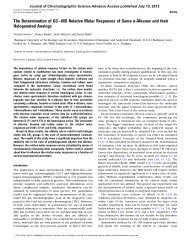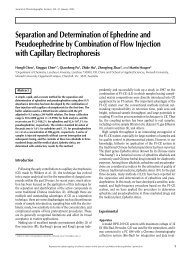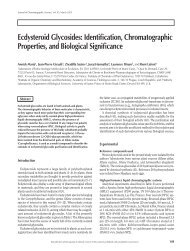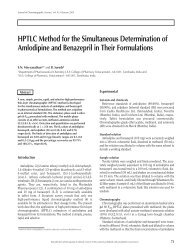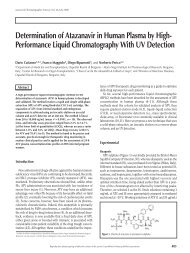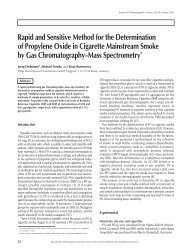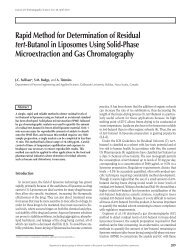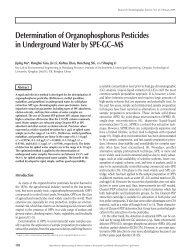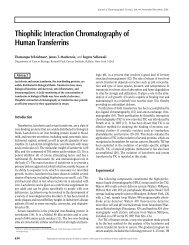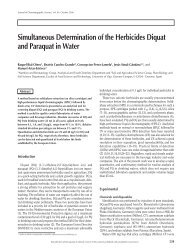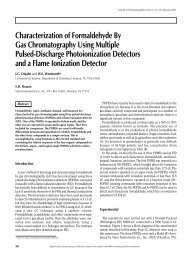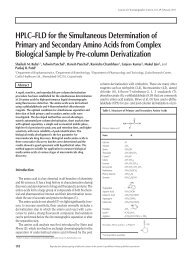Liquid Chromatography–Electrospray Ionization Ion Trap Mass ...
Liquid Chromatography–Electrospray Ionization Ion Trap Mass ...
Liquid Chromatography–Electrospray Ionization Ion Trap Mass ...
You also want an ePaper? Increase the reach of your titles
YUMPU automatically turns print PDFs into web optimized ePapers that Google loves.
Journal of Chromatographic Science, Vol. 46, January 2008<br />
each metabolite provides detailed substructural information of<br />
its structure. So, using the product ion spectrum of parent drug<br />
as a substructural template, metabolites presented in crude mixtures<br />
may be rapidly identified and detected based on their<br />
changes in molecular masses (∆M) and spectral patterns of<br />
product ions, even without standards for each metabolite<br />
(10–12).<br />
Scopolamine is a kind of tropane alkaloid separated from<br />
various solanaceous species (13), such as the roots of Chinese<br />
traditional medicine Anisodus tanguticus (Maxim.) Pascher.<br />
Scopolamine has widespread physiological activities such as<br />
spasmolytic, anaesthetic, acesodyne, and ophthalmic effects<br />
(14,15). In recent years, more and more pharmacological<br />
activities of scopolamine have been investigated and widely<br />
noticed. Compared with the comprehensive investigations into<br />
its therapeutic purpose, the study of its metabolism in vivo or in<br />
vitro is limited, although the metabolic study of scopolamine<br />
plays an important role in the development of new drugs and<br />
their clinical applications.<br />
Some analytical assays have been developed for the quantitation<br />
of scopolamine in plants and pharmaceutical samples or in<br />
urine, based on capillary electrophoresis–diode arrayelectrospray–MS<br />
(16) and HPLC (17–19). Also, pharmacokinetic<br />
studies have been performed by GC–MS (20–22) and LC–MS n<br />
(23). However, metabolic studies of scopolamine in vivo have not<br />
been reported except in three papers (24–26). Werner and<br />
Schmidt (24) described the formation of metabolites such as 6hydroxyatropine,<br />
scopine, and scopolamine glucuronide. Wada<br />
and Yamada et al. (25,26) found three major metabolites (phydroxyscopolamine,<br />
m-hydroxyscopolamine, and p-hydroxy-mmethoxyscopolamine)<br />
and the unchanged drug in rat by the<br />
combination of multi-approaches such as thin-layer chromatography,<br />
GC, GC–MS, and nuclear magnetic resonance. Because<br />
scopolamine and its metabolites are highly polar, thermolabile,<br />
and easy to undergo pyrolysis in the injector block of a GC, the<br />
GC or GC–MS method used is not satisfactory in the analysis of<br />
metabolism of scopolamine. In addition, the urine samples were<br />
prepared using 7% HCl at 100°C, which result in many<br />
metabolites decomposing.<br />
We applied the LC–MS n technique to identify the metabolites<br />
of scopolamine in the rat (27). LC–MS n provides molecular mass<br />
and structural information depending upon fragmentation<br />
patterns. It permits direct analysis of intact polar non-volatile<br />
conjugates without derivatization and/or hydrolysis. 18<br />
metabolites were found in rat urine. The major metabolic<br />
pathway of scopolamine in rat was hydrolysis, demethylation,<br />
dehydration, hydroxylation, and sulfate and glucuronide<br />
conjugate.<br />
In order to comprehensively study the metabolism, this work<br />
presents the metabolism of scopolamine in rat feces, urine, and<br />
plasma after administration. The present study also involves the<br />
incubation of scopolamine with intestinal flora and homogenized<br />
liver in order to clarify its in vivo and in vitro metabolic<br />
pathways. Three new metabolites (tetrahydroxyscopolamine,<br />
trihydroxy-methoxyscopolamine, and dihydroxydimethoxyscopolamine)<br />
were found in rat urine after administering<br />
55 mg/kg scopolamine. The parent drug and its<br />
metabolites 7 and 8 (described later) were found in rat feces and<br />
plasma, respectively. Only metabolites 1 and 2 of scopolamine<br />
were identified in rat intestinal flora and homogenized liver<br />
incubation mixtures in vitro, respectively. These metabolites<br />
were detected for the first time in rat feces, plasma, intestinal<br />
flora, and homogenized liver incubation solutions, which will be<br />
useful for future studies involving scopolamine, such as clinical<br />
therapy.<br />
Experimental<br />
Reagents and chemicals<br />
Scopolamine hydrobromide was purchased from Sigma (St.<br />
Louis, MO). Methanol was of HPLC grade (Fisher Chemical Co.,<br />
Inc., Los Angeles CA); water was deionized and double distilled;<br />
all other reagents were of analytical reagent grade.<br />
Apparatus<br />
LC–MS and LC–MS n experiments were performed on an LCQ<br />
Duo quadrupole ion trap MS (ThermoFinnigan Corp, San Jose,<br />
CA) with a TSP4000 HPLC pump and a TSP AS3000<br />
autosampler. The software Xcalibur version 1.2 (Finnigan) was<br />
applied for system operation and data collection. A high-speed<br />
desk centrifuge (TGL-16C, Shanghai Anting Scientific<br />
Instrument Factory, Shanghai, China) was used to centrifuge the<br />
samples. Rat urine samples were extracted on a C18 solid-phase<br />
extraction cartridge (3 mL/200 mg, AccuBond II , Agilent, Palo<br />
Alto, CA). The intestinal incubation experiments were carried<br />
out in anaerobical incubation bags (AnaeroPouch-Anaero<br />
08G05A-23, Mitsubishi Gas Chemical Company, Inc., Tokyo,<br />
Japan) using anaerobical generating bags (Mitsubishi Gas<br />
Chemical Company, Inc.).<br />
Sample preparation<br />
In vivo samples<br />
Five wistar rats (180 ± 5 g, Hubei Research Center of<br />
Laboratory Animals, Hubei China) were housed in metabolic<br />
cages for the collection of feces, urine, and plasma. The rats were<br />
fasted for 24 h but with access to water, and then they were<br />
administered 55 mg/kg oral gavage doses of scopolamine. Feces<br />
and urine were collected individually during the time period<br />
0–24 h. The samples were stored at –20°C until analysis.<br />
Heparinized blood samples of 200 µL were collected at 0.24, 0.75,<br />
2, 9, 18, and 24 h from the ophthalmic veins of the rats by sterile<br />
capillary tube, then shaken and centrifuged at 2000 × g for 10<br />
min. The supernatants were decanted, and immediately frozen at<br />
–20°C until analysis.<br />
The feces samples were homogenized with water. An aliquot of<br />
500 µL feces homogenate was extracted twice with 2 mL of ethyl<br />
acetate after adding 50 µL of 0.001% Na 2CO 3 solution. The<br />
supernatant ethyl acetate layers were decanted and pooled and<br />
evaporated at 37°C under nitrogen. The residue was redissolved<br />
in 500 µL of mobile phase and filtered through 0.45 µm film and<br />
an aliquot of 10 µL was used for LC–MS n analyses.<br />
An aliquot of 1 mL of mixed 0–24 h urine samples was loaded<br />
onto a C18 solid-phase extraction cartridge which was preconditioned<br />
with 2 mL of methanol and 1 mL of water. Then, the SPE<br />
75



